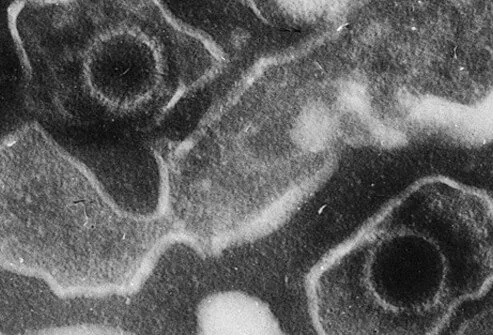infectious mononucleosis article
slideshowmononucleosis, virus,mononucleosis,mononucleosis disease, Epstein-Barr virus, Epstein-Barr ,COUSES,EBV,virus,EBV,slideshow,mononucleosis,disease,mononucleosis disease, mononucleosis couses,mononucleosis management, Epstein-Barr virus,mononucleosis prevention,mononucleosis ,EBV
What is infectious mononucleosis ("mono")? Infectious mononucleosis, "mono," "kissing disease," and glandular
fever are all terms popularly used for the very common illness caused
by the Epstein-Barr virus (EBV). This common viral infection causes
fever, sore throat, and enlarged lymph nodes. The illness generally goes
away without medical help. However, it may last from weeks to months.
Treatment is mainly to ease symptoms, usually at home, with plenty of
rest and fluids.
Infectious mononucleosis (“kissing disease”) is a
very common illness caused by the Epstein-Barr virus (EBV).  What is the Epstein-Barr virus?
What is the Epstein-Barr virus? EBV is a member of the herpesvirus family and causes more than 90%
of cases of mononucleosis. EBV is a double-stranded DNA virus named
for the English virologists professor Sir Anthony Epstein and Yvonne M.
Barr. The designation "mononucleosis" refers to an increase in a special
type of white blood cells (lymphocytes) in the bloodstream relative to
the other blood components as a result of the EBV infection.
EBV is a double-stranded DNA virus named for the English
virologists professor Sir Anthony Epstein and Yvonne M. Barr.  What is the cause of mono?
What is the cause of mono? The EBV that causes mono is found throughout the world. By the
time most people reach adulthood, an antibody against EBV can be
detected in their blood. In the U.S., up to 95% of adults 35-40 years of
age have antibodies directed against EBV. This means that most people,
sometime in their lives, have been infected with EBV. While there are
other illnesses falling under the broad classification of mononucleosis
that cause similar symptoms and an increase in blood lymphocytes, the
form caused by the EBV is by far the most common.
Most people, sometime in their lives, have
been infected with EBV, the virus that causes mono.  What are the risk factors for mono?
What are the risk factors for mono? The EBV can infect anyone. By adulthood, 90%-95% of men and women
have been infected with EBV; infections most often occur in people 5-25
years of age. Not surprisingly, 1%-3% of college students contract mono
each year, as it is most often transmitted via saliva (hence the name
“kissing disease”). However, mono can also be spread through blood and
genital secretions.
By adulthood, 90%-95% of men and women have been infected
with EBV, with infection most often occurring in people 5-25 years of age.  How is mono spread?
How is mono spread? Mono is usually spread by person-to-person contact. Saliva is the
primary method of transmitting mono. Infectious mononucleosis developed
its common name of "kissing disease" from this prevalent form of
transmission among teenagers. A person with mono can also pass on the
disease by coughing or sneezing, causing small droplets of infected
saliva and/or mucus to be suspended in the air and inhaled by others.
Sharing food or beverages from the same container or utensil can also
transfer the virus from one person to another, since contact with
infected saliva may result.
Mono is usually spread by person-to-person
contact with saliva as the primary method of transmission.  How long is mono contagious?
How long is mono contagious? Most people have been exposed to the virus as children, and as a
result of the exposure, they have developed immunity to the virus. It is
of note that most people who are exposed to the EBV don't ever develop
mononucleosis. The incubation period for mono, meaning the time from the
initial viral infection until the appearance of symptoms, is between
four and six weeks. During an infection, a person is likely able to
transmit the virus to others for at least a few weeks.
During an infection, a person is likely able to
transmit the virus to others for at least a few weeks.  Reactivations of mono
Reactivations of mono Research has shown that, depending on the method used to detect
the virus, anywhere from 20% to 80% of people who have had mononucleosis
and have recovered will continue to secrete the EBV in their saliva for
years due to periodic "reactivations" of the viral infection. Since
healthy people without symptoms also secrete the virus during
reactivation episodes throughout their lifetime, isolation of people
infected with EBV is not necessary. It is currently believed that these
healthy people, who nevertheless secrete EBV particles, are the primary
reservoir for transmission of EBV among humans.
Approximately 20%-80% of people who have had mono will continue
to secrete the EBV in their saliva for years due to periodic "reactivations."  What are the symptoms of mono?
What are the symptoms of mono? The initial symptoms of mono are a general lack of energy
(malaise), loss of appetite, and chills. These initial symptoms can last
from one to three days before the more intense symptoms of the illness
begin. The more common intense symptoms include a severe sore throat,
fever, and swollen glands (lymph nodes) in the neck area. It is
typically the severe sore throat that prompts people to contact their
doctor.
The initial symptoms of mono are a general
lack of energy (malaise), loss of appetite, and chills. 






